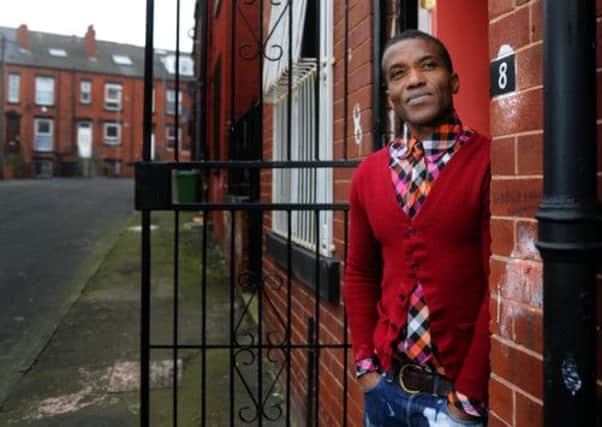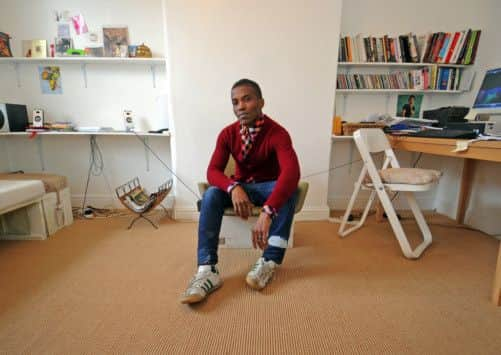How Victor wants to be on the side of the angels to bring homes back to life


Behind the front door of Victor Lewis’s home lies an artist’s studio. One wall is covered with images he’s torn out of magazines, the inspiration for present and future projects and underneath the window sits a sewing machine where he spends hours each day running up some new creation.
It wasn’t always like this. A couple of years ago the property in Beeston was empty, the only inhabitants a couple of pigeons which had taken up residence in the attic room. At the same time Victor was living in a bedsit doing his best to distract himself with plans to launch his own blog and securing funding for his various artistic ventures.
Advertisement
Hide AdAdvertisement
Hide Ad“I would get up every morning and just work, work, work,” says the London College of Fashion graduate. He moved north from the family home in Milton Keynes a few years ago and initially found work designing costumes for a production of Othello. However, as is often the way for those involved in the creative industries, work proved erratic and income irregular. A combination of circumstances meant he unexpectedly had to move out of the place he had been living and in need of emergency accommodation he found himself in the bedsit.


“It was a halfway house for those who had left prison but who hadn’t found anywhere else to go,” he says. “It wasn’t great, but I just tried to ignore everything that was going on and keep myself to myself.”
The weeks turned into months and when Victor began looking for an alternative to life in a bedsit he eventually found his way to the door of Canopy. The self-help, community housing project based in inner city Leeds has a simple enough brief – take a property which has been empty for years, identify a homeless individual or family and then once they commit to helping bring the house back into use they get to live in it.
“This place had been empty for about 12 months and it was in a bit of a bad way,” says Victor, who is working on an installation piece which he hopes might find a home in the new Trinity Leeds shopping development. “Obviously they didn’t let me loose with the electrics or the plastering, but I could help out with the decorating and it meant that even before I had moved in I had a vested interest in the property.
Advertisement
Hide AdAdvertisement
Hide Ad“This isn’t the most affluent suburb, but that has its advantages in that rent is much cheaper. The one thing I do know is that this is the very best house I can afford at the moment. I don’t want to be here forever, but it has given me space to work and to make plans for the future.”
Just a few streets away from where Victor is living there are rows of empty back to backs which have been boarded up for a number of years. Earmarked for demolition under one of the previous Government’s PFI projects they were to be replaced by a modern social housing development.
The artist impressions showed a new community of young families and open green spaces between the housing. However, the dream never became a reality and the funding failed to materialise. It was a similar story, not just in Leeds, but across the whole of Yorkshire and many of the most deprived communities, which were supposed to benefit from the investment, found themselves worse off than before. Those residents who chose to remain have often been left overlooking the abandoned houses, some of which turned into makeshift drug dens and in places where the bulldozers had already moved in, the wasteland has become a dumping ground.
When the plugged was pulled on the PFI projects it also served to exacerbate the problem of empty homes which councils up and down the country have been battling to solve.
Advertisement
Hide AdAdvertisement
Hide AdIn Leeds, about 14,000 properties now lie empty and of those 5,000 have been vacant for six months or more. In Sheffield there are about 3,000 similar properties, while estimates for Bradford put the figure at about 5,000. At the same time there are thousands of people on housing waiting lists.
The problem is money. With local authority budgets tight and with many private developers, nursing burnt fingers from the recent crash, many areas have found themselves in limbo. However, there is a growing number of organisations and individuals who believe that by pooling resources many of these properties can be brought back into use.
Gill Coupland and Rob Greenland are two of them. A year ago, the pair who are behind the social enterprise, Social Business Brokers, turned their attention to the issue of empty homes. Back then they organised a Call to Action Day where they brought various interested parties, from council officials to housing associations, together and a year on they are about to launch a week-long event to try to get the momentum building.
“There are a thousand empty properties and a thousand reasons why they are empty,” says Gill, who also runs Angels. The organisation was set up when Leeds City Council announced it was withdrawing some service care provision and now provides meals on wheels and runs community groups in the city. Leeds Empties is, she says, a natural extension.
Advertisement
Hide AdAdvertisement
Hide Ad“One thing we learnt from last year’s event was just how many people there are who are willing to help. We are not saying that every single empty property can be brought back into use, but it seems crazy that there are people living in temporary accommodation while this valuable housing stocks sits there doing nothing.”
One difficulty is making contact with the owners many of whom have inherited the properties and have lacked the money to be able to make them habitable again. “We have recently taken on one house which belonged to one of our Angel clients,” says Gill.
“When she died, she left the house to her son and he struggled to know what to do with it. There is often an emotional barrier to putting it up for sale or sometimes they simply can’t afford to make the necessary updates so that it can be rented out. Combine that with the fact that we think of property as an asset – even if its standing empty and falling into disrepair and doing nothing seems like the only option.”
Rob and Gill are already working closely with the likes of Canopy and similar organisations called Leeds Action to Create Homes and Gipsil, which operate a scheme which allows the owner to keep their property while at the same time bringing it back into use. The property is handed over to the housing organisation for a set number of years – the length of time linked to how much work needs to be done. The housing organisation recoups the money spent on the repairs through the rent and at the end of the lease it is given back to the individual.
Advertisement
Hide AdAdvertisement
Hide AdBorrowing a little from property programmes, Rob and Gill have also launched an Empty Homes Doctor service where they sit down with owners and explore options from renovation to selling.
“LATCH recently worked with an elderly lady who had left her home and moved into sheltered housing,” says Rob. “She didn’t want to sell just in case she was ever forced to leave the sheltered housing. Of course that was never likely to happen, but having her own house there made her feel secure.
“It’s an entirely understandable reaction, but by handing it over to a social housing organisation for a fixed period means everyone benefits. At the moment most social housing organisations can only make a small dent on a city’s empty property stock, but together we can start to have a real impact.
“One of the areas we want to explore is crowd funding and community share issues. The latter has been successfully used to bring shops back into use and there is every chance it could work for housing. We don’t have all the answers, but one thing we do know is that if you can find a way of bringing properties back into use it doesn’t just benefit those who get to live in them, but can really help to transform entire communities.”
Week of action on ‘empties’
Advertisement
Hide AdAdvertisement
Hide AdLeeds Empties Week will take place between March 18 and 22.
Monday: Launch of the campaign aimed primarily at local businesses.
Tuesday: Visit to two properties which have been brought back into use by Canopy and LATCH.
Wednesday: A breakfast seminar at the Greenhouse in Beeston about investment opportunities.
Thursday: Information sessions for owners of empty homes.
Advertisement
Hide AdAdvertisement
Hide AdFriday: Information sessions for those looking to start social enterprises to target empty homes.
To find out more go to http://leedsempties.wordpress.com/empties-week/
For more information about the work of Canopy go to www.canopyhousing.org